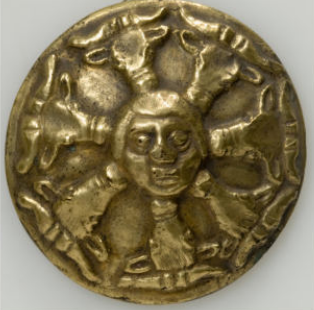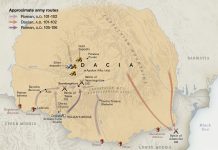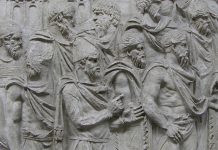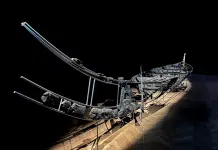A.E. Liutsenko who excavated Alexandropol kurgan in 1854–55, was the first who preserved the skulls of the people who were buried in it. Unfortunately, he did not preserve the skeletons though. But the archaeologists before and for some time after him did not care about collecting any of the skeletons’ remains and science lost extremely valuable information from almost 40 royal barrows in the lower Dnieper area. There were five skulls A.E. Liutsenko uncovered and they are numbered as follows. Skulls # 1 and 2 are the ones found in the central chamber, # 3 is the skull of a servant whose skeleton was found in the passage adjacent to the main chamber, # 4 is the skull of a “groom” whose skeleton was discovered not far from a horse burial, and # 5 is the skull of yet another king. The first one to analyze the skulls was a member of the Russian Academy of Sciences K. E. von Baer. The results were published in the “Antiquities of Herodotus’ Scythia” in 1866 currently available at archive.com. K. Baer observed: “These skulls differ greatly between themselves and can be divided into two absolutely distinct groups: three of them (# 1, 2, 5) should be defined as short and wide, and two other (# 3, 4) – long and narrow. Illustrations below:
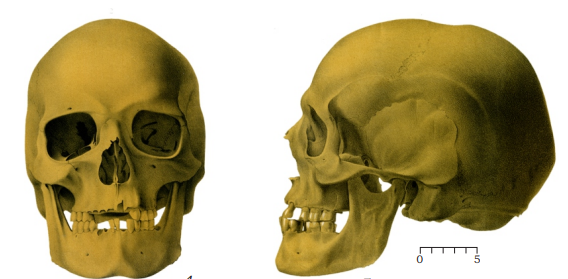
In Baer’s opinion, the two long skulls were so similar in different measurements that should belong to persons of one nationality.
Although the three short skulls were less similar between themselves, the difference was not so big that they could not belong to people of one nation. The widest of the three skulls of this group was skull # 5, and, according to Baer, “unusually heavy” because of the bone thickness. Skull # 1 was also very heavy but not as wide as the previous one. A. E. Liutsenko, who discovered the skulls, left a note describing the skeleton of # 1: “The skeleton bones… judging by their size… belonged to a man of a large height and stout built.”
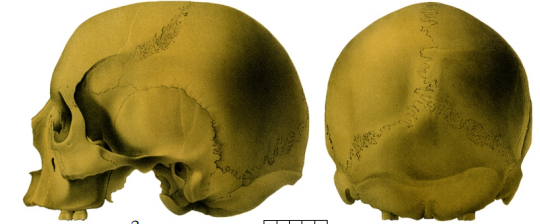
Skull # 2 was the most gracile of the three in this group but initially was believed to belong to a man too. Present-day anthropological analysis showed that skulls from the Central tomb of the Aleksandropol kurgan belong to a man of the advanced age of 50 years or more (# 1), and a young woman of the age of 20-35 years (# 2).
The present-day analysis also confirmed the heterogeneity of the anthropological structure of the buried in Aleksandropol kurgan. Scholars also established that “the royal group” from Alexandropol kurgan shows similarity with the Sauromatians.
Who were the Sauromatians and where did they live? Famous Hippocrates (460 – 370 BC) who was almost a contemporary of Alexandropol kurgan wrote: “And in Europe is a Scythian race, dwelling round Lake Maeotis, which differs from the other races. Their name is Sauromatae“. Herodotus (484 – 425 BC) described a Scythian tribe he called Royal as dwelling in the same area around the Azov Sea. M. Rostovtzeff warned that these “Sauromatians, who were Maeotians, are not to be confounded with the Sarmatians,” and in his words, “the matriarchal life of the dwellers by the Sea of Azov was closely connected with their religious beliefs. Their chief divinity was the Mother Goddess“, and for a long time, the peninsula of Taman, which is the area between the Azov and the Caspian seas known today as Kuban, was covered with sanctuaries of that female deity, whom the Greeks identified with their Artemis, their Aphrodite, and their Demeter.
(We find it important to draw attention to the phrase “Scythian race” by Hippocrates. For this prominent physician, the Scythians were a very distinct race, and not an “Iranian tribe” as modern scholars insist.)
At the time Alexandropol kurgan was erected, the ruling dynasty of the Bosporan Kingdom was the Spartocids, but starting in the first century BC, the dynasty of the Sauromates became the rulers of the kingdom. And it can hardly be a coincidence that those rulers wore the name of the tribe to which the king and queen from Alexandropol kurgan belonged.
Let us have a look at the gold phalerae from Alexandropol kurgan (title image). We see a round face without a beard or mustache encircled by the seven bulls’ heads. The man has a very unusual hairdo with hair parting for that time. It can hardly be a representation of a mythological person, so, most likely it was a portrayal of a king buried in the kurgan (# 5?).
There may be a direct relationship between the Sauromates dynasty of the Bosporan kingdom and the most famous dynasty of Kyiv Rus whom contemporary Byzantine historians called the Tauroscythians. For details check the “Gardariki, Ukraine” e-book.



